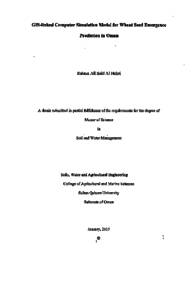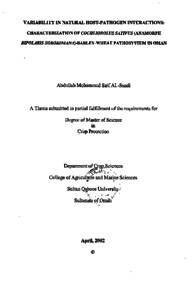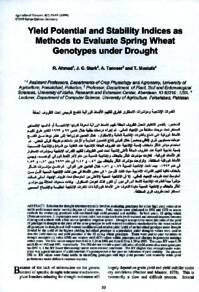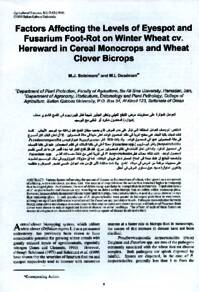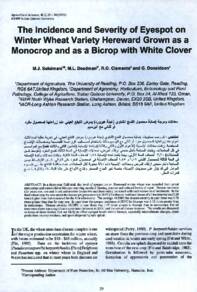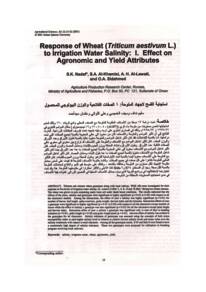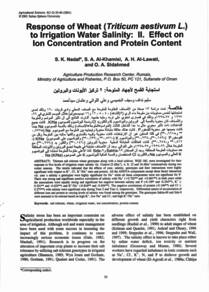Document
GIS-linked computer simulation model for wheat seed emergence prediction in Oman
Publisher
Sultan Qaboos University
Gregorian
2015
Language
English
English abstract
Because wheat is considered as one of the main meals of people and because of the deficiency of wheat production in the Sultanate of Oman compared to the consumption rate, intensive studies were done to improve wheat situation in Oman. The main objective of this study was to delineate (map) the best locations of wheat production in Oman through linking Wheat Simulation Model with Numerical Weather Prediction Model (NWPM) in Geographic Information System (GIS). This project helps in improving wheat production in Oman through the ability to predict the percentage of wheat emergence in a specific area based on main and governing factors. The emergence of the wheat is affected by climatic conditions, soil properties and plating depth. Time and percentage can be predicted by a wheat simulation model that is based on planting depth, soil temperature and soil water potential. To validate the model's result, four field trials, over two seasons have been conducted at agricultural extension station at Sultan Qaboos University. The experiment was factorial in a randomize complete block design with three replicates of two varieties (Coli and KW1) * two planting depth (2.5 and 5 cm) * Two planting date (1st December 2013 and 22 January 2014 ). The results showed that there is a good agreement between findings of field experiment and predicted outcome from the model. When water potential was -0.015 MPa, soil temperature was 22°C and planting depth was 2.5 cm, emergence started after day four from planting and maximum emergence percentage was 74% after day 11 from the planting date. The model result shows that, emergence started after day 5 from planting and maximum emergence percentage was 67% achieved after day seven from the planting date. Also field experiment showed, two planting depth (2.5 and 5 cm) has no effect in the physical characteristics of wheat. However, planting time has effect on physical characteristics of wheat.
The model gave very good results when it was tested using data obtained from the computational models and comparing the results with field experimental data. Four field trials, over two seasons, have validated positively the linkage of the developed model with the geographic information system. The developed model can be promoted as a tool of improving wheat cultivation through making the most of available water in wheat production and increasing the growing acreage of wheat in arid regions like Oman
Description
Thesis
Member of
Resource URL
Arabic abstract
يعتبر القمح واحدا من المصادر الغذائية الأساسية التي يحتاج إليها الإنسان ونظرة إلى قلة إنتاج القمح بالسلطنة مقارنة بمعدل الإستهلاك ، فقد أجريت العديد من الدراسات المكثفة لتحسين وضع إنتاج القمح في السلطنة . لذلك فإن الهدف الرئيسي لهذه الدراسة هو رسم خريطة لأفضل مواقع إنتاج القمح في السلطنة من خلال ربط نموذج محاكاة القمح بنموذج التنبؤ العددي للطقس في نظام المعلومات الجغرافية. يساعد هذا المشروع على تحسين إنتاج القمح في سلطنة عمان من خلال القدرة على تنبؤ نسبة العائد من القمح في منطقة معينة ، وذلك بالإعتماد على العوامل الأساسية المسيطرة ومنها الظروف المناخية ، وخصائص التربة وعمق الزراعة. أما وقت الإنتاج ونسبته يمكن التنبؤ بها من خلال نموذج محاكاة القمح الذي يقوم على أساس عمق الزراعة ، ودرجة حرارة التربة ومقدار الطاقة الكامنة للمياه في التربة. وللتحقق من صحة نتائج النموذج ، فقد تم إجراء أربعة تجارب ميدانية على مدى موسمين في محطة الإرشاد الزراعي بجامعة السلطان قابوس ، حيث كانت التجربة تحت عوامل التصميم العشوائي الكامل مع تكرارها تجريبيا ثلاث مرات متضمنة صنفين من القمح (كولي و ك.و.1) تمت زراعتهما بعمقين مختلفين ( 2 . 5 سم و 5 سم) و في وقتين مختلفين (15 ديسمبر 2013 و 22 يناير 2014). أظهرت النتائج أن هناك توافق جيد بين نتائج التجارب الميدانية والنتائج المتوقعة من هذا النموذج. عندما كانت كمية المياه - 0 . 015 ، ودرجة الحرارة 22° سليزية ، وعمق الزراعة2 . 5 سم ، بدا الزرع بالظهور بعد اليوم الرابع وكان الحد الأقصى للظهور بنسبة 74% بعد اليوم الحادي عشر من تاريخ زراعته. كما أظهرت نتائج النموذج أن النبتة بدأت بالظهور بعد اليوم الخامس من تاريخ زراعتها ووصلت النتية الحد الأقصى للظهور بنسبة 67% بعد اليوم السابع. إضافة إلى ذلك، أظهرت نتائج التجربة الميدانية بأن عمق الزراعة الإثنين (2.5 سم و5 سم ) ليس لهما تأثير في الخصائص الفيزيائية للقمح. أما وقت الزراعة كان له تاثير في بعض خصائصه الفيزيائية أعطى النموذج المستخدم نتائج جيدة للغاية عندما تم اختباره بإستخدام البيانات التي تم الحصول عليها من نماذج حسابية ومقارنة هذه النتائج بالبيانات التجريبية الميدانية. فقد ساعدت الأربع تجارب على مدى موسمين في التحقق إيجابية من الربط بين النموذج المطور ونظام المعلومات الجغرافية . ويمكن تعزيز النموذج المطور كأداة لتحسين زراعة القمح من خلال الإستفادة القصوى من المياه المناخية في إنتاج القمح وزيادة مساحة زراعته في المناطق الجافة مثل المناطق الموجودة بالسلطنة.
Category
Theses and Dissertations

